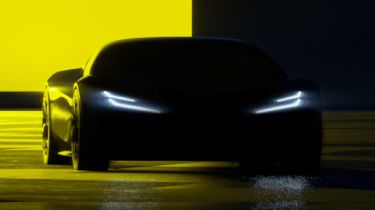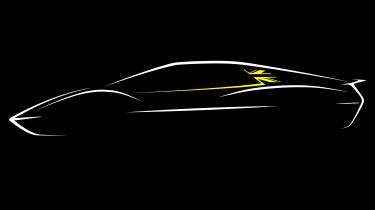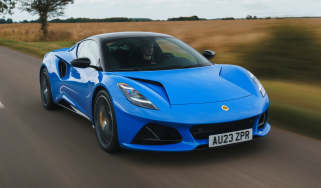Lotus ‘Type 135’ is a £75,000 electric sports car due in 2025
Zero-emissions Lotus Emira replacement will be built in the UK on a bespoke sports car architecture
Lotus will use its Hethel base in Norfolk to build an electric successor to the Emira sports car, Auto Express can confirm. The zero-emission model – currently codenamed Lotus Type 135 – will be the brand’s fourth pure-EV, utilising a bespoke platform developed and assembled in the UK.
Speaking at an exclusive media briefing in London, Lotus Group’s chief commercial officer Mike Johnstone told us: “The plan is for Type 135 to be designed and manufactured in the UK. Hethel is going to be an important part of our future.”
The new two-seat successor to the Emira is on track to be revealed next year. Lotus has also confirmed it is targeting a starting price of $95,000 (circa £75,000) when production starts in 2027.
There had been some doubt cast about the future of Lotus’s historic headquarters, after the maker confirmed its factory in Wuhan, China, had capacity to build up to 150,000 cars annually – meeting the brand’s overall sales target once its four core models are up and running. The Chinese facility is currently building the Eletre SUV, with production of the Emeya due to start imminently. It’ll also manufacture a smaller electric SUV from 2026.
Work on the Type 135 is well underway. The car will look to do battle with the next-generation electric Porsche Cayman and Boxster. Johnstone said: “for us, what’s important is it’s the bullseye of the brand. So even though it’s electrified, it needs to have the same spirit as the Emira, as the Exige, as the Evora, etc, going back over the last 75 years. It needs to encapsulate the pure sprint of what that Lotus sports car should be.”
Lotus’s Chief creative officer Ben Payne dismissed any questions as to whether or not mass-market saloons and SUVs were right for the brand insisting that if founder Colin Chapman was still around he would undoubtedly have embraced electrification.
“Look at history, look at F1,” he told us. “[Lotus] was at the leading edge in terms of hardware. Our customers are super-savvy; they need stories. It’s layered up on where the brand has come from.”
When it finally arrives, the Type 135 will sit alongside the petrol-powered Lotus Emira on showroom floors for a very brief period. Johnstone told us that, despite the UK government’s decision to delay the ban on sales of new petrol and diesel cars until 2035, the Emira is still being retired in 2028 as planned, thus going down in the history books as the last-ever petrol-powered Lotus.
Lotus and Alpine collaboration
Lotus and performance brand Alpine were expected to work on this electric sports cars project together, with the French firm in the process of creating a zero-emissions successor to its featherweight A110. However the two parted ways earlier this year. Johnstone said “there were some advantages to working with Alpine, but that was always more of an exploration than a commitment as it was under a memorandum of understanding.
“Both parties decided actually it was better doing it slightly differently from each other,” he told us. “There’s a really good relationship that remains in place now.”
Lotus was also working with battery specialist Britishvolt to develop the new technology that would be key to the Type 135, however the firm entered administration for the second time in January 2023 and its future is currently unclear.
However the announcement of the collaboration between Lotus and Britishvolt did at least provide us with a teaser image of the Type 135. It hints at an Esprit-like silhouette, with a roofline and windowline that appear similar in shape to those of the brand’s iconic mid-engined supercar, along with a similarly pointy nose. The strong, pronounced haunches over the front and rear axles of the vehicle are more in keeping with the brand’s latest performance car design language, drawing inspiration from the Evija electric hypercar and the Emira.
The other similarly shadowy teaser image of the Type 135 gives us little except an idea of the unique split headlight design it’ll sport, which looks to be very similar to the Emeya’s.
Lotus electric sports car platform
We also know that the Type 135 won’t be using the same ‘Electric Premium Architecture’ as the Eletre or Emeya. Nor will it use the shortened version of the same architecture planned for the Type 134 D-segment SUV. Instead, it’s set to use a bespoke layout just for electric sports cars, known internally as ‘E-Sports’. It incorporates a lightweight rear-subframe developed through the company’s ‘Project LEVA’ (Lightweight Electric Vehicle Architecture) that Lotus says can accommodate various battery designs and sizes, plus one or two electric motors but only to drive the rear wheels.
In 2021, Lotus outlined details of two potential two-seat sports car applications using the versatile architecture. The first had a wheelbase of at least 2,470mm – around the same as the current Porsche Cayman’s. It could be fitted with a 66.4kWh battery and used one 469bhp e-motor. The other had a wheelbase of at least 2,650mm – not too far off the all-electric MG Cyberster’s – could be fitted with a whopping 99.6kWh battery and featured two motors producing up to 872bhp.
Both would utilise a ‘chest’ layout for the battery, whereby it’s stacked vertically behind the passenger seats. This setup would provide a similar weight distribution and centre of gravity to a typical mid-engined petrol sports car, plus a low ride height. Alternatively, the battery could be positioned under the car’s floor, like it is in almost every EV, with Lotus suggesting this design would work better for a ‘2+2’ sports car.
What do you think of the electrification plans for Lotus? Let us know in the comments...
Find a car with the experts










